F1x A-class foiling catamaran
World champion, lighter = better, craftsmanship, meet the foiling f1x a-class catamaran.
This is the ultimate singlehanded foiling catamaran of the moment: ultramodern, incredibly fast, very agile, extremely strong and feather-light, in an aerodynamic and ergonomic design. The perfect total package, packed in 1 foiling catamaran. This is the world’s coolest boat for singlehanded races and the winner of several A-cat world championships and many other sailing races.
The 2020-F1x A-cat is exactly the same foiling catamaran that made Mischa Heemskerk Vice-World Champion at the Herveybay Worlds 2018 in Australia and World Champion at Weymouth 2019. All our foiling F1x A-class catamarans come straight, ready to race and ‘Mischa-tuned’ from our factory.

Unique design enables top performances
The F1x A-class foiling catamaran is the ultimate reflection of our current design language. The aerodynamic design accentuates the performance qualities of this super fast foiling racing boat. The sophisticated deck plan provides clear control and minimal air resistance.
Foils The rudders and daggerboard foils used on the F1x A-class foiling catamarans are produced with the highest quality carbon pre-preg fibers. The foils are cured in our own Autoclave . Our winning foil design was created in close cooperation with Glenn Ashby and the designers of AC Team New Zealand .
Construction The F1x A-cat is manufactured entirely according to the carbon pre-preg/ Nomex production method, and cured in our Autoclave. This technology is the same as used in the aerospace industry and within other foiling boats like for example, the America’s Cup.
Design The design of the F1x foiling A-class catamaran was completely conceived by the DNA design team and made at DNA’s own yard. In the DNA design team Pieterjan Dwarshuis, Mischa Heemskerk and the renowned Dutch industrial design engineer Rudo Enserink worked closely together to create the perfect foiling A-class catamaran.
We build your new foiling boat!
Technical details.
The F1x A-class foiling catamaran has a number of unique features that improve performance. For example:
- Semi ridged trampoline. Gives extra torsional stiffness to the boat and increases its aerodynamic characteristics.
- Patented main-sheet-wheel-system. For more direct and faster trim of the main sail.
- Aerodynamically placed traveller car.
- Flexible daggerboard casings. For minimal water absorption in floating mode.
- Aerodynamically shaped ‘beams’.
- Adjustable T-rudders. Foiling with rudder differential is possible.
Specifications
LOA: 5.49 m BOA: 2.30 m Max. draught: 1.20 m Sail area: 13.94 m Total weight: ca. 53 kg Top speed: 31 kn Extra: All measurements according to IACA Class regulations.
Buy a champion's boat!
Are you excited to buy a F1x A-class foiling catamaran from DNA Performance Sailing? Please fill in our contact form:
Yes, I want a F1x A-cat!
Schrijf je in voor onze nieuwsbrief en blijf op de hoogte van de nieuwste ontwikkelingen.
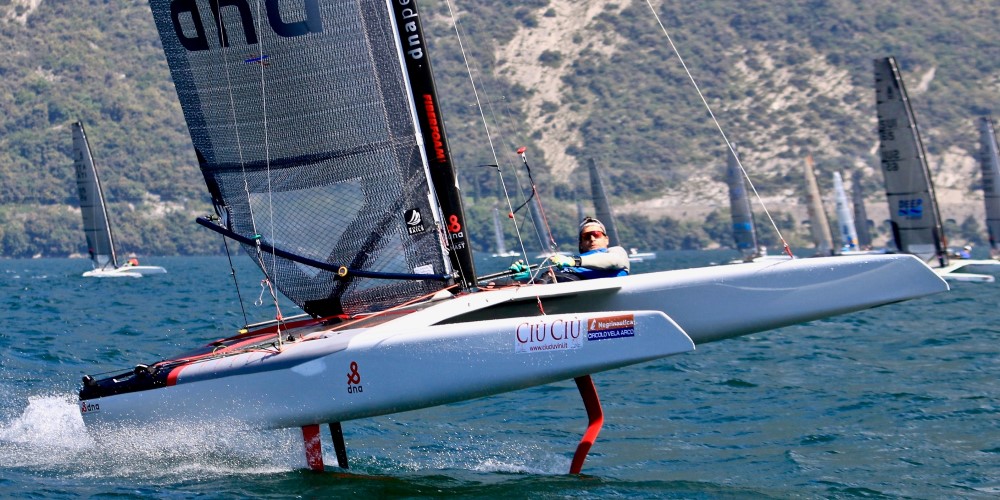
Contactformulier
- Company Name
- Full name * First Last
- Emailaddress *
- Phonenumber *
- Mijn vraag betreft * My question: TF10 F1x G4 F4 Custom Parts Hydrofoils Other
- Comments This field is for validation purposes and should be left unchanged.
Registrieren Sie sich für unseren Newsletter
lassen Sie sich über die neuesten Entwicklungen informieren!
- E-Mail-Adresse *
- Name This field is for validation purposes and should be left unchanged.
Schrijf je in voor onze nieuwsbrief
blijf op de hoogte van de nieuwste ontwikkelingen!
- First name *
- Last name *
- Phone This field is for validation purposes and should be left unchanged.
Wij gebruiken cookies om u de beste online ervaring te bieden. Door akkoord te gaan, accepteert u het gebruik van cookies in overeenstemming met ons cookiebeleid.
Wanneer u een website bezoekt, kan deze informatie in uw browser opslaan of ophalen, meestal in de vorm van cookies. Beheer hier uw persoonlijke cookiediensten.
- wordpress_test_cookie
- wordpress_logged_in_
- wordpress_sec

- WINDFOIL BOOM
- FORMULA KITE FOIL
- KITEFOIL RACEBOARD
- ONE PIECE CARBON BAR
View Cart Checkout
- No products in the cart.
Subtotal: € 0,00
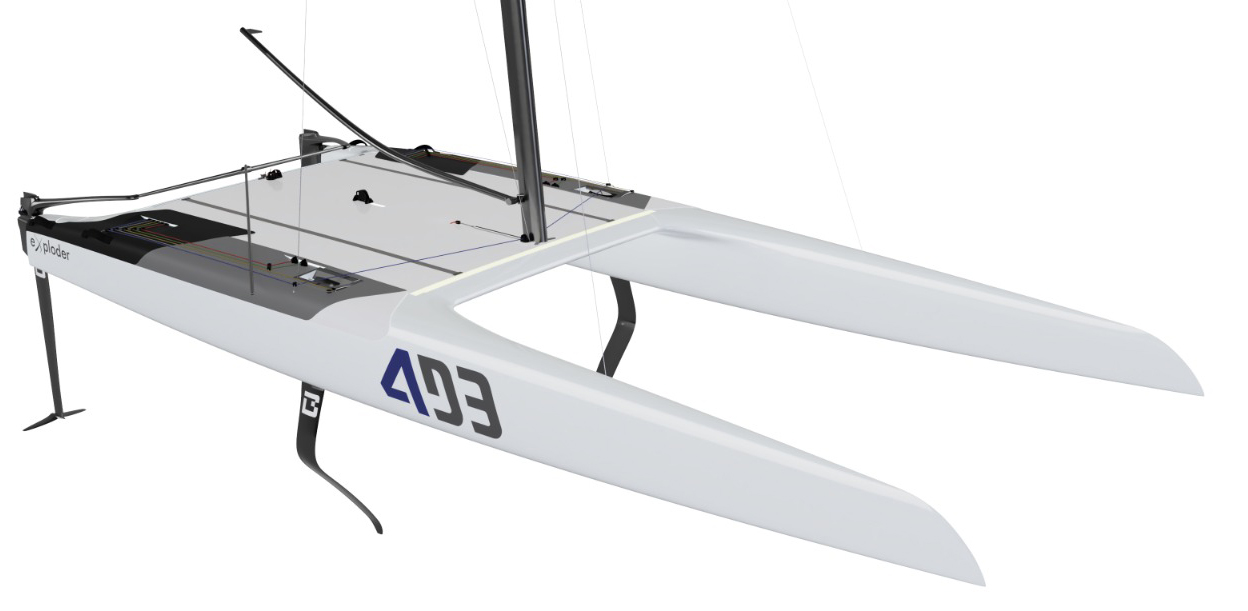
eXploder AD3 is A-Class sailing catamaran – one of the fastest singlehanded sailing boats on the water. The eXploder A-Class cats have been in production since 2013 and in that time won a staggering 6 World Championship titles and 15 Continental titles Since it’s conception the eXploder platform has been improved over and over again. The focus behind the current boat has been aerodynamics. Optimised hulls and foils / rudders / daggers are constantly being tested and improved.
OPTIMISED DAGGERBOARDS/RUDDERS OUTLINES AND PROFILES
Tweaked and tested foils are not only incredibly fast, but also easy to control. This is a race-winning combination. When a customer buys a new boat, it is always provided with the latest, fastest, tested foils / rudders / daggers.
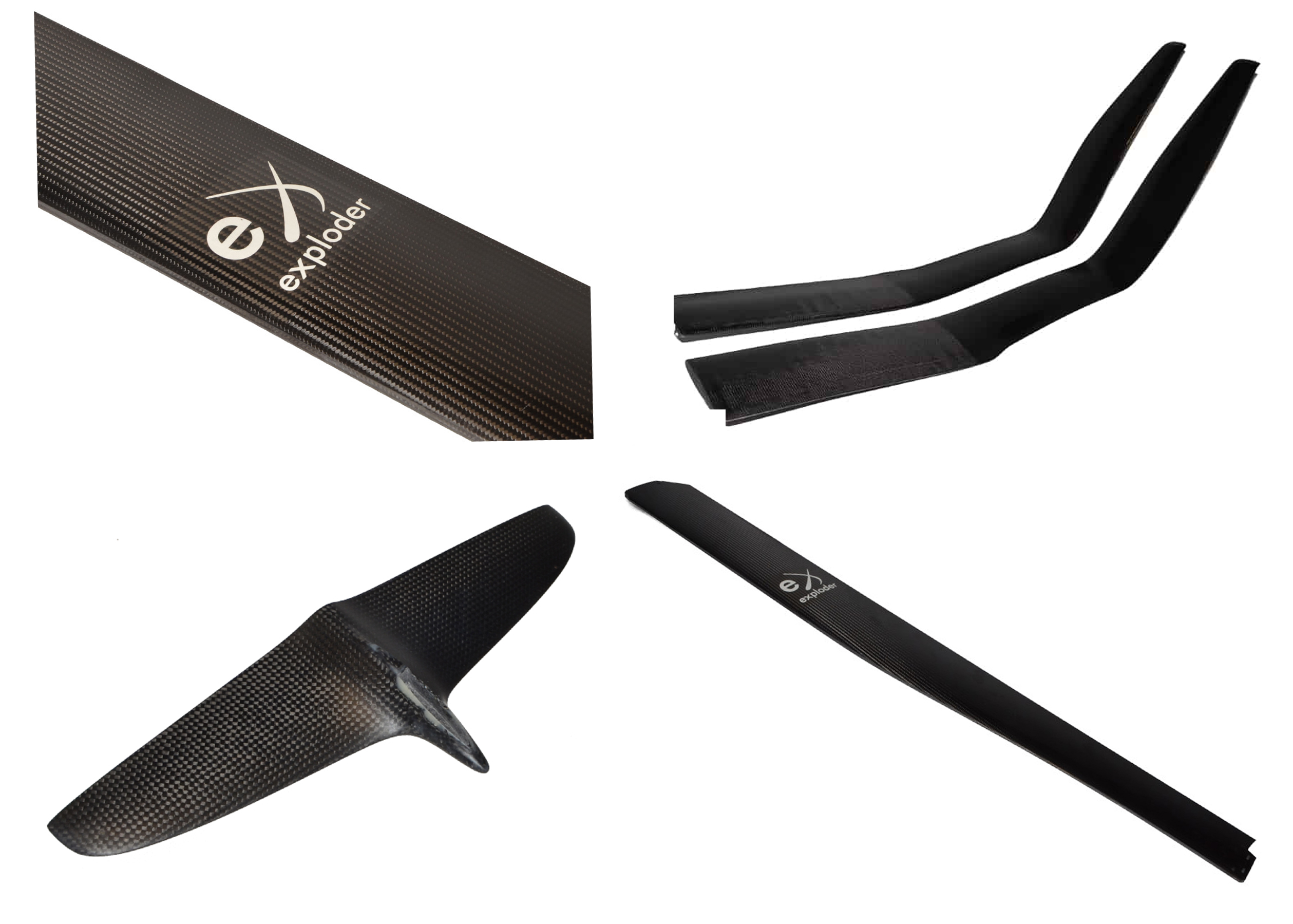
FOCUS ON AERODYNAMICS
Hulls, beams, double-layered trampoline, hull-beam connections – all these parts are optimised for drag reduction. Together with D3 Applied Technologies we’ve ran countless tests and CFD simulations to try to understand where the biggest efficiency gain lies. This is not a hydro story anymore, it’s a flying object! Also the whole package is designed to be very clean and as visually appealing as possible.
EASY ANGLE TRIM
All the foil trimming systems are clean and easy to operate on any course, allowing on the fly trimming, including rudder differential in either displacement of foiling mode.
All boat elements are designed to be durable, failure-free and easy to operate and manufactured using the latest in material and technology
READY TO SAIL
The eXploder AD3 is provided with all needed systems and even trim markings making initial boat set-up intuitive. To go out on the water, everything what is needed is to put a mast on, insert foils / rudders in their slots, hoist a sail and attach a Cunningham and a mainsheet.
WORLD CHAMPIONSHIP PROVEN
In our business the only way to determine performance is through results. The eXploder AD3 has won 6 World and 15 Continental titles in the last 7 years.
DESIGNER / R&D TEAM COMMENT
“The AD3 2020 model is the result of over a decade of learning, testing, failing, succeeding at times, and overall, developing these boats. With the previous platform we made some compromises from a design perspective, enabling us to build test boats over the years with different board and beam locations. It has been a very successful platform, widely used by the majority of the class. However, in the last couple of years we have been considering changing the daggerboard cases, but in order to respect our philosophy, that would require a new platform. So last year we tested a few systems on the 2019 AD3 (carbon traveller car, rudder differential, etc), and prepared the grounds to design a new model in 2020.
You have limited opportunities to design a new platform, and in most projects, new ideas sometimes fade away in the design process as we face boatbuilding realities (materials, tooling, custom hardware, etc). On this model we were given plenty of freedom in terms of shapes and surfacing, and for once this was maintained until the end. The aero-package of an upwind-foiler is one of the main drivers of performance, and this boat is very clean in that aspect.
We took the opportunity to update the foils (Z42) and the rudder elevators. We not only changed the rondure and planform but also the family of foil sections following the most recent design tool developments. As of rudder lift control, we can sail now with a more extreme rudder differential. Righting moment is the horsepower of any boat, so this is a huge performance gain, particularly upwind.
The rest was our typical process of designing a racing boat: countless design iterations, CFD for aero and hydrodynamics, VPP iterations to update polars etc From a hydro point of view, this hull is designed as a foiler, so we ended up reducing the volume, rocker and freeboard of the hulls. Interestingly, we managed to reduce drag at lower speeds (2 hull downwind and non-foiling upwind).
The bar was set as high as it gets with it’s predecessor but we are 100% confident that the AD3 is another step towards the ultimate performance. “

How Do Hydrofoil Catamarans Work? (The Science Behind It Explained)

Have you ever wondered what it would be like to fly on the water? Hydrofoil catamarans are designed to do just that, and many people are amazed by the experience of gliding across the water at speeds that are unheard of with traditional boats.
But what are hydrofoil catamarans, and how do they work? In this article, well explain the science behind these revolutionary boats and explore the advantages, design considerations, and safety precautions that come with them.
Well also look at some examples of hydrofoil catamarans to show you just how powerful and advanced they are.
So, if youve ever wanted to know how these boats work and what sets them apart, read on!
Table of Contents
Short Answer
Hydrofoil catamarans work by using foil-shaped wings that protrude from the bottom of the boat, below the water line.
The foils are designed to lift the vessel out of the water, reducing the surface area touching the water, and therefore reducing drag.
As the boat moves forward, the airflow on the foils generate lift, causing the boat to rise out of the water and glide along the surface.
The foils act as an air cushion, allowing the boat to travel at higher speeds than a regular catamaran.
What are Hydrofoil Catamarans?
Hydrofoil catamarans are a type of boat that use hydrofoils to lift the hull above the water.
This reduces drag, allowing for faster and smoother sailing than traditional boats.
Hydrofoils are wings that protrude from the hull of the boat and are designed to lift the boat out of the water.
This reduces the amount of water resistance and allows the boat to travel faster.
The hydrofoils are adjustable, allowing the boat to be tuned to the desired speed.
Hydrofoil catamarans offer an efficient and fast way to travel on the water, making them a popular choice for recreational and competitive sailing.
The hydrofoils work by creating lift as the boat moves through the water.
As the boat moves, the water flow pushes against the hydrofoils and creates a pressure differential.
This pressure differential creates lift, which lifts the boat out of the water and reduces drag.
The hydrofoils also reduce the amount of wave resistance, allowing the boat to glide through the water.
The hydrofoils can be adjusted to match the speed of the vessel, allowing the boat to be optimized for maximum performance.
The angle of attack of the hydrofoils is also adjustable, allowing the boat to be tuned to the desired speed.
The fins are designed to keep the boat stable and can be adjusted to match the speed of the vessel.
In conclusion, hydrofoil catamarans are a type of boat that uses hydrofoils to lift the hull above the water.
How Do Hydrofoils Work?

Hydrofoils are a type of boat that uses a set of wings or fins to lift the hull above the water.
The hydrofoils are attached to the hull and use the water pressure to propel the boat forward.
The wings of the hydrofoils are designed to reduce the amount of wave resistance, allowing the boat to glide through the water with greater efficiency.
The wings are usually made of lightweight materials such as carbon fiber or aluminum and are designed to produce lift when the boat is moving at a certain speed.
The wings can be adjusted to different angles, which can increase or decrease the lift.
When the boat is moving, the hydrofoils create a low-pressure zone underneath the boat.
This low-pressure zone reduces the amount of drag and improves the efficiency of the boat, allowing it to move faster and more smoothly.
The hydrofoils also help to reduce the amount of wave resistance, allowing the boat to glide through the water with less effort.
They are suitable for all kinds of sailing, from racing to cruising.
Hydrofoils can be adjusted to match the speed of the vessel, making them an excellent choice for those who want to sail faster.
Hydrofoils are also a great choice for those who want to reduce their environmental impact.
Hydrofoils reduce drag, which means that they require less fuel to move the boat, resulting in lower emissions.
Hydrofoils are a great way to reduce the environmental impact of sailing while simultaneously enjoying a faster and smoother ride.
Advantages of Hydrofoil Catamarans
Hydrofoil catamarans offer a unique and efficient way to travel on the water.
The hydrofoil design reduces drag, allowing the boat to glide through the water with greater speed and stability than traditional boats.
The hydrofoils are attached to the hull and use the water pressure to propel the boat forward, creating less wave resistance than a traditional boat.
This allows the boat to move faster and smoother, while using less fuel.
Additionally, the fins can be adjusted to match the speed of the vessel, making it easier to control.
The design of the hydrofoil catamaran also allows it to ride high above the water, reducing drag and contact with the water surface.
This allows for a smoother ride, allowing the boat to move faster with less fuel consumption, and less noise and vibration.
Additionally, the hull shape of the hydrofoil catamaran is designed to increase its stability and maneuverability, further reducing drag and allowing for a faster and smoother ride.
The combination of the reduced drag, increased stability, and smoother ride makes hydrofoil catamarans a popular choice for recreational and competitive sailing.
The ability to move quickly and efficiently makes them ideal for racing, and the increased stability and maneuverability makes them well-suited for recreational activities such as sightseeing or fishing.
Additionally, the reduced contact with the water surface can help to protect the hull from damage, making the boat more durable and longer-lasting.
Overall, hydrofoil catamarans offer an efficient and fast way to travel on the water, making them a popular choice for recreational and competitive sailing.
The combination of reduced drag, increased stability, and smoother ride makes them an ideal choice for anyone looking to get the most out of their time on the water.
Factors Affecting Hydrofoil Performance

The performance of a hydrofoil catamaran depends on a variety of factors, including the type of hydrofoil, the size and shape of the hull, and the speed and direction of the wind.
The hydrofoil itself is an important factor in determining the performance of a hydrofoil catamaran.
Different types of hydrofoils offer different levels of lift, drag, and stability, so its important to choose the right hydrofoil for the job.
The size and shape of the hull also affects the performance of the hydrofoil catamaran, as the hull is the part of the boat that provides the buoyancy and helps the boat to stay afloat.
The speed and direction of the wind also affects the performance of a hydrofoil catamaran, as a headwind or tailwind can cause the boat to be pushed or pulled in a certain direction.
Finally, the weight of the vessel also affects the performance of a hydrofoil catamaran, as a heavier boat will require more lift from the hydrofoil to remain afloat.
Design Considerations for Hydrofoil Catamarans
Hydrofoil catamarans are a special type of boat that use a unique design to offer efficient and fast travel on the water.
The key component of the design is the hydrofoil, which is a fin-like structure attached to the hull that uses the water pressure to push it forward.
This reduces drag and wave resistance, resulting in a smoother, faster sailing experience than traditional boats.
When designing a hydrofoil catamaran, there are a few important considerations that engineers must take into account.
The hydrofoils must be designed so that they can be adjusted to match the speed of the vessel, as well as provide stability and reduce wave resistance.
Additionally, they must be constructed from durable materials to ensure they can stand up to the elements and provide a reliable ride.
The shape of the hull also plays an important role in the performance of a hydrofoil catamaran.
A rounded hull is ideal for reducing drag, while a flat hull is better suited for stability.
As for the size of the hydrofoils, they should be big enough to lift the boat above the water, but not so large that they create too much drag.
Finally, the placement and size of the hydrofoils must be carefully calculated to ensure the boat can reach its maximum speed while remaining stable.
It is also important to consider the weight of the boat and its passengers when designing a hydrofoil catamaran, as this will affect the performance of the hydrofoils.
By taking all of these factors into consideration, engineers can design hydrofoil catamarans that are both fast and stable, providing an enjoyable and efficient ride.
Examples of Hydrofoil Catamarans

Hydrofoil catamarans come in a variety of shapes and sizes, making them suitable for a variety of applications.
Popular examples of hydrofoil catamarans include the America’s Cup boats, the A-class catamaran, as well as the Nacra and Tornado catamarans.
The America’s Cup boats are the fastest boats in the world and are designed to achieve speeds of up to 50 knots.
The A-class catamarans are lightweight and designed for racing, while the Nacra and Tornado catamarans are designed for recreational sailing.
Each of these boats use hydrofoils to reduce drag and improve performance.
In addition to recreational and competitive sailing, hydrofoil catamarans are also used for transportation.
The Sea Eagle is a high-speed ferry that uses hydrofoils to reduce drag and increase its top speed.
The ferry is capable of carrying up to 250 passengers and can reach speeds of up to 50 knots.
Other examples of hydrofoil catamarans include the hovercraft, which uses a combination of air and water pressure to lift the vessel above the water, and the AirFish, which uses a combination of air and water pressure to fly above the water.
Hydrofoil catamarans are an efficient and fast way to travel on the water, making them popular for recreational and competitive sailing, as well as for transportation applications.
The hydrofoils reduce drag and increase performance, allowing these boats to reach speeds of up to 50 knots.
The design of the hydrofoils can also be adjusted to match the speed of the vessel, allowing for a smoother and more efficient ride.
Safety Precautions for Hydrofoil Catamarans
Hydrofoil catamarans are a popular choice for recreational and competitive sailing due to their efficiency and speed.
However, these vessels require extra caution to ensure the safety of all passengers.
Before operating a hydrofoil catamaran, it is important to understand the safety precautions needed to ensure an enjoyable and safe experience.
First, always wear a personal floatation device (PFD) when operating a hydrofoil catamaran.
This will provide a layer of protection if you fall overboard.
Additionally, if the hull of the boat is lifted above the water, it is important to check the area for any debris or objects that may be submerged.
This could cause damage to the boat or injure passengers.
It is also important to check the weather conditions before going out on a hydrofoil catamaran.
Wind, waves, and storms can all be hazardous for these vessels.
They are not suitable for rough water and should be avoided during inclement weather.
Additionally, it is important to check the engine and fuel levels before embarking on any voyage.
Finally, it is important to understand the limitations of the hydrofoil catamaran.
These vessels are designed for speed and maneuverability, not stability.
They are not intended for large groups or for carrying heavy cargo.
The hydrofoil system can also be easily damaged by impacts with rocks and other objects so it is important to be aware of your surroundings and avoid any obstacles.
By taking the proper safety precautions, you can ensure an enjoyable and safe experience while operating a hydrofoil catamaran.
Always wear a PFD, check the weather conditions, and understand the limitations of the vessel before going out on the water.
With the proper preparation, you can enjoy the speed and efficiency of a hydrofoil catamaran for many years to come.
Final Thoughts
Hydrofoil catamarans are a unique type of boat that offers an efficient, fast, and smooth sailing experience.
The hydrofoils lift the hull out of the water, reducing drag and wave resistance, allowing the boat to glide through the water.
With the right design considerations and safety precautions, hydrofoil catamarans can be an enjoyable and safe way to travel on the water.
If youre looking for a fast and efficient way to get out on the water, hydrofoil catamarans may be the perfect option for you.
James Frami
At the age of 15, he and four other friends from his neighborhood constructed their first boat. He has been sailing for almost 30 years and has a wealth of knowledge that he wants to share with others.
Recent Posts
Who Makes Banana Boat? Unveiling the Manufacturer Behind the Sunscreen Brand
Banana Boat is a brand of sunscreen and suncare products that is owned by Edgewell Personal Care. They specialize in creating products designed to protect the skin from the sun's harmful rays while...
How to Ride a Banana Boat Like a Pro: A Complete Guide
If you're looking to ride a banana boat, here's a quick guide to get you started. Firstly, make sure you have a life jacket on for safety. Next, hold on tight to the handles and brace yourself for a...

Professional BoatBuilder Magazine
The efficiency of a foiling powercat.
By Dieter Loibner , Mar 13, 2020

Matanzas Watercraft’s founder, Jan Brandt, in his office with a rendering on the wall and the prototype of the Matanzas 29 foiling powercat peeking through the shop door.
Motivated by his own boating experience and America’s Cup foiling technology, a startup builder launches the Matanzas 29, a new breed of powercat for fishing and cruising.
Wherever Jan Brandt goes, a constant companion since his childhood days in Hamburg, Germany, is his passion for watersports. Competitive swimming, surfing, waterskiing, fishing, scuba diving, sailing, you name it, he’s done it—and still does. No surprise, then, that Brandt is also deeply involved with boats, not just using them but also designing and building them. His latest project is a 29 ‘ (8.8m) foil-assisted planing cruising power catamaran designed for twin outboards from 60 hp to 90 hp. Last fall, construction was far advanced as Brandt prepped for finishing, outfitting, and getting the boat ready for sea trials off St. Augustine, Florida, where he set up shop as Matanzas Watercraft LLC.
Inspired by the Sliver 29, a catamaran designed for fishing and weekending, built by SuperCat in South Africa , Brandt defined specifications that suited his own use patterns and his home port in St. Augustine. “I am looking to build a day-use cat for fishing offshore waters but also capable enough to make the run to Bimini and Abacos on a calm summer morning,” his design brief reads. Also on the list: sufficient load capacity for three to four people for day use and provisions for a couple to cruise for a few days; a range of 200 nm on one tank; and a cruising speed of 20 to 25 knots. Brandt: “I need to deal with a 2–3 ‘ [0.6m–0.9m] chop and Atlantic Ocean swells. While an open cockpit with center console and hardtop is totally sufficient, a head and dry storage for gear with maybe just enough space for a bunk for two would be awesome.” Since crab or lobster pot buoys are not much of a concern in Florida, Brandt explored the idea of foil assist to reduce power requirements and improve seakeeping. However, he was adamant about the ability to safely beach the cat and limit overall beam to 9.1 ‘ (3m) to keep the trailering permits manageable.

The Matanzas 29 plywood/carbon prototype has wave-piercing bows with a positive rake and peaked decks that shed water quickly. The bows’ fine entry flattens out toward the stern to encourage planing, even when operating without foils.
He did some preliminary design work himself, but when the project got serious he consulted with Bieker Boats of Anacortes, Washington. Principal Paul Bieker served as the lead designer of the Oracle America ’s Cup sailing team and was instrumental in developing the outrageously fast 72 ‘ (22m) foiling catamarans that ushered in a foiling revolution following the 2013 Cup on San Francisco Bay. Bieker now applies variations of the foiling concept to pleasure craft, most recently with an innovative 53 ‘ (16m) sailing catamaran intended for racing and weekend cruising (see “ Fledging the Eagle ,” Professional BoatBuilder No. 182) and now with Brandt’s foiling powercat.
The basic idea behind foiling is maximizing efficiency while curbing the need for big engines, a notion that has yet to find footing with production boatbuilders. Brandt: “I’m not interested in boats over 25 ‘ [7.6 m] running 250- or 300-hp twin motors. I’ve been doodling around for a year on the idea, spent more time on the hullform, and when I decided to pull the trigger on building one, that’s when I contacted Paul to help me finalize the design, incorporate some of the design criteria and requirements, and make it work from an engineering perspective. He helped crystallize the hull shape and get the details fleshed out.”
Foiling Tech Trickle-Down
A former racing sailor who campaigned a Mini 650, Brandt met Bieker in 2010 while cruising the waters of Puget Sound. He ran his own environmental consulting firm in Seattle and also took up boatbuilding. First came stitch-and-glue kayaks, but soon he graduated to the PT Skiff, an 18′ (5.5m) kit boat by Port Townsend Watercraft designed by Bieker and Russell Brown. With Brown’s encouragement Brandt designed and built the cedar-strip carbon composite Syhoya , a handsome 21 ‘ (6.4m) weekend cruiser powered by a 60-hp Evinrude E-Tec outboard for cruising Puget Sound and beyond.

Previously, Brandt designed and built Syhoya, a 21’ (6.4m) weekender with a 60-hp outboard for cruising the coastal waters of the Pacific Northwest.
In Brandt’s painstakingly clean and organized workshop a 10-minute drive from his house in St. Augustine Beach, Bieker’s plans laid out on the workbench and the prototype of the Matanzas 29 under construction showed how personal predilection, boating experience, and exposure to innovative design ideas informed his choices. For a simple boat that aims to maximize efficiency and minimize power requirements, the design process was complicated. Some salient features, like the combination of planing hulls with wave-piercing bows and the foil arrangement most commonly associated with fast sailing cats, seem a bit counterintuitive at first, but Brandt explained the underlying thinking.
He wanted to minimize the fatigue of the acceleration/deceleration forces when running the steep chop of St. Augustine Inlet during an outgoing tide, “letting the bows do the work,” rather than endure slamming, Brandt explained. “That’s when we combined the wave-piercing hulls with the foil assist in order to get away from larger engines while still being able to carry the displacement we need, all the things we added that were part of my criteria—the fish boxes and the scuba gear. All that weighs quite a bit, [but we wanted] to manage that with reasonably small motors. That’s how we got to wave-piercing bows and the foils.” Load-carrying capacity, especially at speed, is another reason he decided against displacement hulls.

Passengers can ride on the main deck, under the hardtop, or on the “rumble seat” forward.
Why plywood/composite instead of carbon-reinforced plastic construction, which would have further minimized weight? Brandt reasoned it was less complex and costly for a prototype that has to establish proof of concept and test the nascent market for foiling powerboats. Tooling up for a production run is his goal. The thin plywood—okoume 6mm/1⁄4 “ for the topsides, 9mm/0.35 “ for the bottom—is sheathed in E-glass, a laminate schedule of 200-g (5.9-oz) and 300-g (8.95-oz) layers inside and out. Turn Point Design in Port Townsend cut the kit, based on design files it received from Bieker Boats. “That worked perfectly. We have had zero issues with the wood fit,” Brandt recalled. “Every puzzle joint fit the first time.” For the foam-core portions of the boat, he used 20mm (0.79 “ ) Divinycell H80 sandwiched between multiple layers of regular-modulus carbon woven roving of 5.9 oz 0°/90°, and 2×2 twill weave of the same weight, which conforms well to complex 3D shapes. For taping and to reinforce high-load areas, Brandt applied 400 g/m2 (11.8 oz/sq yd) of 45° double biaxial carbon and 9 oz/sq yd (305 g/m2) unidirectionals.
The entire wet deck, measuring 18 ‘ x 10 ‘ (5.49m x 3.05m), was vacuum-bagged with the foam core and three layers of carbon fiber on each side, laid up in various directions. That’s a large piece to build in a compact workspace, so he tackled it first and then stored it against the wall to make room for hull construction. Florida’s warm, humid climate imposes its own demands on working with resins, which ideally are catalyzed and processed in an ambient temperature around 65°F (17°C). Brandt planned to get the big parts done during the cooler time of year, turning on the air-conditioning if necessary and starting at 3 a.m. Doing “the large areas of the hull, we had three layers of glass on the bottom, so running that over 30′ [9.14m] in one shot, even just hand layup, gets challenging, because the initial pot cures before you have the last layer on.” That’s a herculean task for one, but he had help from his wife, Tonya, and then hired some neighborhood kids to do some sanding.

This angle shows the square sterns, the cutouts for the fuel hoses and steering lines, the carbon-reinforced main deck, and the storage boxes.
In addition to all this new construction, Brandt still found opportunities to include some repurposed parts from his Mini 650, which he had raced from Newport to Bermuda and in West Coast regattas. In his stash of spare kit was an extra boom—a 3.7m (11.15 ‘ ) raw carbon tube from CST Composites that always traveled with the boat. It became the beam that holds the anchor roller and forms the front terminus of the foredeck, Brandt noted, adding that he cut and fit sections of carbon spinnaker poles to support the cat’s hardtop.
Outboards with Mustache Foils
As originally conceived, the boat was to be powered by twin 60-hp Suzuki DF 60A three-cylinder outboards. However, working with technicians at Suzuki Marine of North America , which rents shop space from him next door, Brandt opted for the four-cylinder DF 90A, which he considered a better fit for the prototype’s offshore work and for testing the custom mustache foils. Granted, the DF 90A packs 50% more power and a third more weight than a DF 60A, but it’s still modest compared to twin 300s often seen on boats of similar size.

Custom-designed carbon mustache foils on the cavitation plate will boost stern lift as their attitude is adjusted by the tilt and trim mechanisms of the outboards.
“I don’t need 55 knots; 25 is awesome. That’s fast cruising,” he declared. “Every now and then…it’s nice to be in the 30s to run home, but that’s plenty.” If it sounds extreme, Bieker wanted even less. “I think he was initially uncomfortable with the speeds I wanted, until we had a discussion about what the market expects,” Brandt laughed. “The mentality is ‘I gotta be able to go 30, gotta be able to outrun a thunderstorm. I’ve got 40 or 50 miles to the Gulf Stream, and I want to get there in reasonable time.’ Paul’s sweet spot is 15, 16 knots, because you can do that with a lot less power. To go from 16 to 22 knots is a big jump, but 16 knots is not where the market is; it’s not where the utility of the boat is. So I had to push the area of power where he was less comfortable and the threshold of where he did not want to be associated with. That was a big compromise. I credit him for coming my way.”

Outward-facing J-foils forward carry most of the displacement when deployed. Their angle of attack is manually adjustable by ±2° with a sliding bolt, and hinge pins allow the foils to fold up when not in use.
The production of the mustache foils (named after their shape) was outsourced to Chris Maas on Center Island, Washington, a former builder of custom rowing shells and International Sailing Canoes. He said he was using his 3-axis CNC router to machine molds from MDF board and construct the foils in wet layup with Pro-Set epoxy. These foils will be mounted to the cavitation plate, so any adjustment in the angle of attack comes from the outboards’ tilt and trim mechanisms. The main appendages amidships are outward-facing J-foils (similar to those on the 31 ‘ /9.45m Foiler by Enata Marine; see PBB No. 173, pages 39–40). A hinge pin at their heads allows them to fold up when not in use, while the angle of attack is adjusted manually when the boat is stopped, by slacking two bolts and sliding the hinge mechanism fore and aft for a range of ±2°.
“We lofted all the layers carefully,” Bieker said of the foil construction that was performed by Simon Miles, a carbon fiber fabricator in Port Townsend. “We came to 167 layers,” Bieker continued. “Typically we get to within 1mm of the target shape. The structural spar is solid, and toward the trailing edge there’s some hi-temp PVC foam core.” It will be done in five to six cooks at 250°F/121°C (see the sidebar below).
In foiling mode the cat will not be in “full flight” with hulls clear of the water but rather skimming along the surface. As simple and sensibly powered as the boat is, Brandt still wants the capacity to carry a payload of approximately 1,600 lbs (725 kg) for fuel (2 x 35 gal/132.5 l), water (14 gal/53 l) food, paddle, and surfboards, fishing, and scuba gear, a porta-potti, some electronics, and a small refrigerator. To cover his energy needs for starting and house loads, he’ll go with 2 x 75-Ah lead-acid batteries with 650-amp cold-cranking capacity. Two 100-watt solar panels on the hardtop and intermittent charging from the alternators when motoring should keep the lights on and the beer cold.

Deck, stern, and side views reveal the arrangement of the boat with foils deployed and folded up. Note the mustache foils mounted to the cavitation plates of the outboards to increase lift and help trim the boat.
Brandt named his company Matanzas Watercraft after the river that runs past St. Augustine, where he attended high school after emigrating from Germany with his family in the 1980s. Dating back to those days, he knows the surf spots, gnarly riptides, and choppy patches where sea breeze and ebb collide. After dialing in the new boat during sea trials, which include a trip to the Bahamas to test it as a cruising, fishing, and diving platform, he hopes this America ’s Cup–inspired concept will generate the interest that warrants a limited production run. Ideal customers, Brandt reckoned, are sailors who share his passion for water sports, value his high-tech approach to efficiency, and “don’t necessarily need the power that generally is the norm in the market.” It’s a bold bet but one that seems right for the times. “The intent is there, and we have the facilities to do it,” he added.
Dieter Loibner is editor-at-large of Professional BoatBuilder.
Cooking the Foils
While Jan Brandt of Mantanzas Watercraft was putting the finishing touches on his Matanzas 29 powercat in St. Augustine, Florida, the foils were being made at the diagonally opposite corner of the lower 48, in Port Townsend, Washington, roughly 2,500 miles (4,023 km) distant. Working inside his barn workshop that used to house a boatbuilding shop called Seven Seas, carbon fiber technician Simon Miles, 31, stood next to the carbon tool he’d built for the job. He was warming swatches of prepreg with a heat gun to help them stick to the adhesive film he had previously put on top of the cured substrate of the first cook.

Simon Miles heats the prepreg to bond it to an adhesive film he put down onto cured substrate in the foil mold.
Having worked for Oracle’s America ’s Cup team and Mad Fiber, a Seattle company that made high-end carbon racing wheels, Miles is very much at home with high-end carbon work, but this job was new territory, because it required high-temperature tooling, and he was using a new source for the intermediate-modulus prepreg required.
The tooling was built from a plug of machined medium-density fiberboard (MDF). The monolithic carbon mold is infused with Pro-Set High-Temp infusion resin using Sigmatex 660 g/m2 (19.5 oz/sq ft) of 2 x 2 twill, a ply of 200-g/m2 (5.9-oz/sq-ft) woven carbon, and two coats of Pro-Set High-Temp tooling putty against the machine-tool-face end to limit print-through of the heavy woven cloth.

Infusion of the carbon tool.
The centerpiece of the foil project is a 20 ‘ -long (6.1m) shipping container the previous owner converted into a giant oven for constructing high-end carbon fiber parts. “It has Roxul insulation and stainless walls inside,” Miles explained, “and there is a huge heater/blower unit from Electroheat.” For this project, Miles moved the container/oven into his workshop and hooked it up to three-phase power.
To help lower the cost, Miles sourced 108 yd of 190-g/m2 (5.6-oz/sq-ft) unidirectional 250 prepreg from Composite Recycling Technology Center (CRTC) in Port Angeles, Washington. The material was rejected for use in aerospace applications, hence the substantial savings. At CRTC it was stored at 0°F (–17.8°C), which is common for prepreg. Once out of the freezer it must be processed quickly, but the cool ambient temperatures of the Pacific Northwest winter (at or below 50°F/10°C) allowed Miles enough time to complete the work.

Some complexities: The foils, designed by Bieker Boats, comprise 167 layers of carbon laminate, 144 of them unidirectional 0°, the rest off-axis plies (±45°). In the lower part of the foil, the structure will include foam core (Divinycell H100 foam) and Gurit SE 84 laminates. Miles said he planned to switch to the lower-temperature prepreg so the foam does not “blow up.” At 250°F (121°C) H100 distorts, changing density and dimensions, but SE 84 cures below that threshold at a cooler 176°F (80°C). Miles said he would still precook the Divinycell to reduce the chances of expansion after the foam had been shaped. To finish, he will use woven cloth for wrapping, and SE 84 as well. Lastly, the B-side will be faired and sanded.
Miles estimated total construction time would run eight weeks for a springtime delivery.
Dieter Loibner
Read more Companies , Construction , Design articles

- Van der Werff’s Curved Wood
A Dutch yard adopts composite panel molding technology to build boats from preshaped wooden hull sections.

- Departures: Carl Chamberlin
Passionate, competent, considerate, modest, and thoughtful is how designer and boatbuilder Carl Chamberlin is remembered by those who knew him. He died last November at age of 75 in Port… Read more »

SAFE Boats Regains Small-Business Status with Employee Ownership
More than 20 years ago, Professional BoatBuilder ran a feature titled “God, Country and Fast Boats” (No. 85, page 64) about SAFE Boats International (SBI), a Bremerton, Washington–based manufacturer of aluminum boats…. Read more »

Recent Posts
- There was Only One Partner I’d Trust for the Refurb Project of my Life: AkzoNobel
- Citimarine Store Expands to a New State of the Art Location in Miami
- Find out how 3D printing can help your boatbuilding with MASSIVIT
- Companies (85)
- Construction (106)
- Design (161)
- Drawing Board (10)
- Education (25)
- Environment (16)
- Events (21)
- Materials (50)
- Obituary (18)
- People/Profiles (49)
- Products (16)
- Propulsion Systems (32)
- Racing (16)
- Repair (37)
- Rovings (317)
- Short Cuts (3)
- Sponsored Partner News (16)
- Systems (80)
- Task Sheet (1)
- Uncategorized (26)
- Wood to Glass (7)
ProBoat.com Archives

Support our hydrofoil educational content for free when you purchase through links on our site. Learn more
[2023] Hydrofoil Catamaran: The Ultimate Guide to Foiling on Water
- November 1, 2023
- Hydrofoil Basics
Experience the thrill of flying above the water with a hydrofoil catamaran!
Are you ready to take your hydrofoil boarding to the next level? Look no further than the hydrofoil catamaran. In this comprehensive guide, we’ll dive deep into the world of hydrofoil catamarans, exploring their history, how they work, their benefits and drawbacks, and everything else you need to know to make an informed decision. So, buckle up and get ready to soar above the waves!
Table of Contents
Quick answer, quick tips and facts, how does a hydrofoil catamaran work, benefits of hydrofoil catamarans, drawbacks of hydrofoil catamarans, choosing the right hydrofoil catamaran, maintenance and care, recommended links, reference links.
A hydrofoil catamaran is a type of watercraft that combines the stability of a catamaran with the lift and speed of hydrofoils. It uses specially designed foils to lift the hulls out of the water, reducing drag and allowing for faster and smoother sailing. Hydrofoil catamarans are popular among sailors and water sports enthusiasts for their incredible speed, maneuverability, and thrilling foiling experience.
Shopping Links: Hydrofoil Catamarans on Amazon | Hydrofoil Catamarans on Walmart | Hydrofoil Catamarans on Etsy
- Hydrofoil catamarans can reach speeds of up to 40 knots (46 mph) or more, depending on the design and conditions.
- The foils on a hydrofoil catamaran can lift the hulls out of the water, reducing drag and allowing for a smoother and faster ride.
- Hydrofoil catamarans are used for various purposes, including racing, recreational sailing, and even transportation.
- Foiling on a hydrofoil catamaran requires some skill and practice, but it’s an exhilarating experience once you get the hang of it.
- Hydrofoil catamarans come in different sizes and designs, catering to different skill levels and preferences.
Hydrofoil catamarans have a fascinating history that dates back to the early 20th century. The concept of using hydrofoils to lift boats out of the water and reduce drag was first explored by Italian engineer Enrico Forlanini in the late 1800s. However, it wasn’t until the 1950s that hydrofoil technology started to gain traction in the boating world.
The first hydrofoil catamaran, known as the “Aquavion,” was developed by the French engineer René Guilbaud in the 1950s. This innovative design combined the stability of a catamaran with the lift of hydrofoils, revolutionizing the world of sailing. Since then, hydrofoil catamarans have evolved and become more advanced, offering incredible speed, maneuverability, and stability on the water.
A hydrofoil catamaran works by utilizing hydrofoils, which are wing-like structures mounted underneath the hulls of the boat. These foils generate lift as the boat gains speed, lifting the hulls out of the water and reducing drag. This lift allows the hydrofoil catamaran to achieve higher speeds and a smoother ride compared to traditional boats.
The hydrofoils on a catamaran are typically designed with a curved shape, similar to an airplane wing. This shape creates a pressure difference between the upper and lower surfaces of the foil, generating lift. The foils are usually adjustable, allowing the sailor to fine-tune the performance of the catamaran based on the sailing conditions.
To control the hydrofoil catamaran, sailors use a combination of steering and sail trim. By adjusting the angle of the foils and the sails, they can optimize the lift and balance of the boat, ensuring a stable and efficient ride. It takes some practice to master the art of foiling on a hydrofoil catamaran, but the rewards are well worth the effort.
Hydrofoil catamarans offer a range of benefits that make them a popular choice among sailors and water sports enthusiasts. Here are some of the key advantages of hydrofoil catamarans:
Speed : Hydrofoil catamarans are known for their incredible speed. By lifting the hulls out of the water, hydrofoils reduce drag and allow the boat to glide smoothly above the waves. This enables hydrofoil catamarans to reach impressive speeds, making them a thrilling choice for racing and high-performance sailing.
Maneuverability : The lift generated by hydrofoils enhances the maneuverability of catamarans. With reduced drag, hydrofoil catamarans can make sharp turns and quick maneuvers with ease. This agility is particularly useful in racing scenarios, where every second counts.
Stability : The dual-hull design of catamarans provides inherent stability, even at high speeds. When combined with hydrofoils, the stability of hydrofoil catamarans is further enhanced. This stability makes them suitable for sailors of all skill levels, from beginners to experienced professionals.
Efficiency : Hydrofoil catamarans are more efficient than traditional boats. By reducing drag, hydrofoils allow the boat to sail faster while using less power. This increased efficiency translates to longer sailing distances and reduced fuel consumption, making hydrofoil catamarans an environmentally friendly choice.
Versatility : Hydrofoil catamarans are versatile watercraft that can be used for various purposes. Whether you’re looking for a high-performance racing catamaran or a recreational sailboat for family outings, there’s a hydrofoil catamaran to suit your needs. Some models even offer the option to switch between foiling and non-foiling modes, providing flexibility on the water.
While hydrofoil catamarans offer numerous benefits, it’s important to consider their drawbacks as well. Here are a few potential downsides to keep in mind:
Cost : Hydrofoil catamarans tend to be more expensive than traditional boats. The advanced technology and materials used in their construction contribute to the higher price tag. Additionally, maintenance and repairs can also be costly, especially if specialized parts or services are required.
Learning Curve : Foiling on a hydrofoil catamaran requires some skill and practice. It can take time to learn how to control the boat effectively and maintain stability while flying above the water. Beginners may find the learning curve steep, but with dedication and proper instruction, anyone can master the art of hydrofoil catamaran sailing.
Weather Conditions : Hydrofoil catamarans are sensitive to weather conditions. While they excel in flat water and moderate winds, rough seas and strong gusts can pose challenges. It’s important to be aware of the weather forecast and choose suitable sailing conditions to ensure a safe and enjoyable experience.
Transportation and Storage : Hydrofoil catamarans can be larger and bulkier than traditional boats, making transportation and storage more challenging. Specialized trailers or racks may be required to transport the catamaran, and adequate storage space is needed to protect it when not in use.
Despite these drawbacks, the thrill and excitement of foiling on a hydrofoil catamaran outweigh the challenges for many sailing enthusiasts.
When it comes to choosing the right hydrofoil catamaran, there are several factors to consider. Here are some key points to keep in mind:
Skill Level : Consider your skill level and experience as a sailor. Some hydrofoil catamarans are designed for advanced sailors, while others are more beginner-friendly. Choose a catamaran that matches your skill level to ensure a safe and enjoyable sailing experience.
Intended Use : Determine how you plan to use the hydrofoil catamaran. Are you looking for a racing catamaran, a recreational sailboat, or something in between? Different models offer varying features and performance characteristics, so it’s essential to choose a catamaran that aligns with your intended use.
Budget : Set a budget for your hydrofoil catamaran purchase. Prices can vary significantly depending on the brand, model, and features. Consider both the upfront cost and the long-term maintenance expenses when determining your budget.
Brand and Reputation : Research different brands and their reputation in the hydrofoil catamaran industry. Look for brands with a track record of producing high-quality, reliable catamarans. Reading customer reviews and seeking recommendations from experienced sailors can also provide valuable insights.
Demo and Test Sails : Whenever possible, try out different hydrofoil catamarans before making a final decision. Many manufacturers and dealers offer demo and test sails, allowing you to experience the performance and handling of the catamaran firsthand. This hands-on experience can help you make an informed choice.
Remember, choosing the right hydrofoil catamaran is a personal decision that depends on your individual preferences and needs. Take your time, do your research, and consult with experts to find the perfect catamaran for your hydrofoil adventures.
Proper maintenance and care are essential to keep your hydrofoil catamaran in top shape and ensure its longevity. Here are some maintenance tips to help you keep your catamaran performing at its best:
Rinse with Fresh Water : After each sailing session, rinse your hydrofoil catamaran with fresh water to remove salt and debris. Pay special attention to the foils, as saltwater can cause corrosion over time.
Inspect for Damage : Regularly inspect your catamaran for any signs of damage or wear. Check the foils, hulls, rigging, and sails for any cracks, dents, or loose fittings. Address any issues promptly to prevent further damage.
Store Properly : When not in use, store your hydrofoil catamaran in a dry and secure location. If possible, keep it covered to protect it from the elements. Consider using a boat cover or storing it in a boat shed or garage.
Follow Manufacturer’s Guidelines : Follow the manufacturer’s guidelines for maintenance and care. Each catamaran may have specific recommendations for cleaning, lubrication, and other maintenance tasks. Adhering to these guidelines will help prolong the life of your catamaran.
Seek Professional Assistance : If you’re unsure about any maintenance tasks or need assistance, don’t hesitate to seek professional help. Local boatyards, sailing clubs, or authorized dealers can provide expert advice and services to keep your catamaran in optimal condition.
By following these maintenance tips and caring for your hydrofoil catamaran, you can enjoy many years of thrilling foiling adventures on the water.
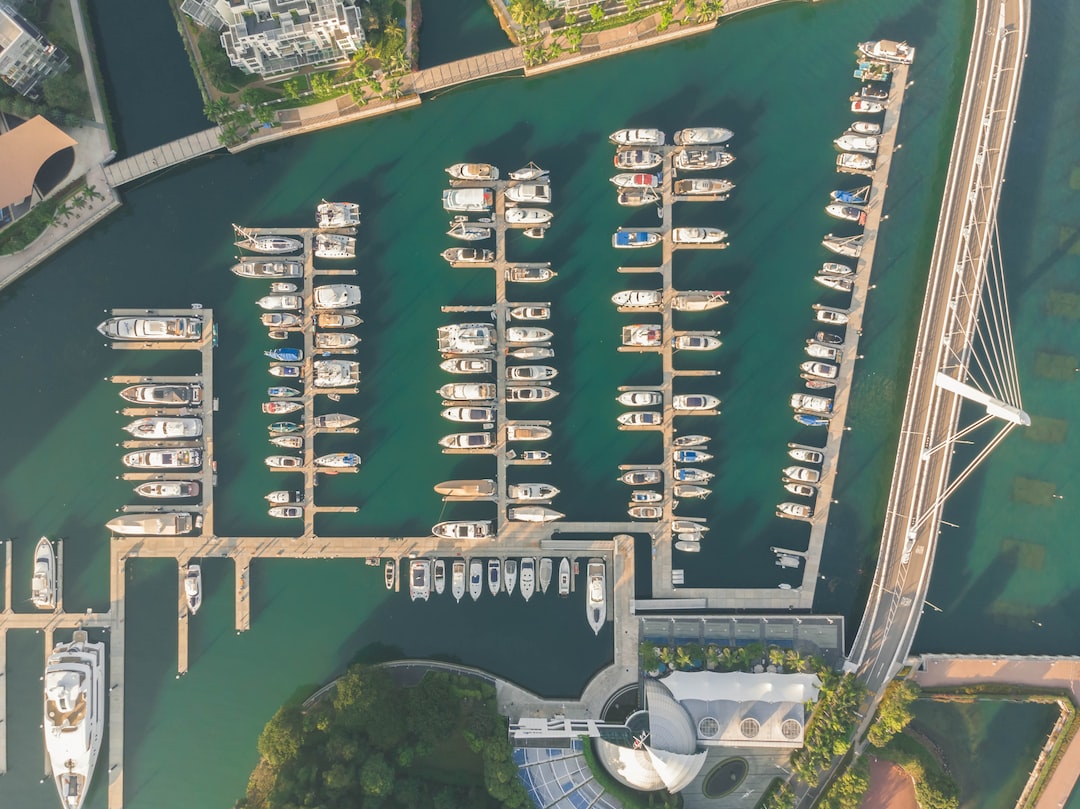
How fast is the hydrofoil catamaran?
Hydrofoil catamarans can reach impressive speeds, depending on various factors such as the design, wind conditions, and skill of the sailor. Some high-performance hydrofoil catamarans can exceed 40 knots (46 mph) or more. However, the exact speed will vary based on these factors.
How does a foil catamaran work?
A foil catamaran, also known as a hydrofoil catamaran, works by utilizing hydrofoils to lift the hulls out of the water. These foils generate lift as the boat gains speed, reducing drag and allowing for faster and smoother sailing. The lift created by the foils enables the catamaran to “fly” above the water, resulting in increased speed and improved performance.
What happened to hydrofoils?
Hydrofoils have a rich history and have been used in various applications, including passenger ferries, military vessels, and recreational boats. While hydrofoils experienced a surge in popularity in the mid-20th century, their use declined in some sectors due to factors such as high costs, maintenance challenges, and the development of alternative technologies. However, hydrofoils continue to be used in niche markets, including high-performance sailing and racing.
Read more about “… What is the World’s Largest Hydrofoil Boat?”
Are hydrofoil boats more efficient?
Yes, hydrofoil boats are generally more efficient than traditional boats. By lifting the hulls out of the water, hydrofoils reduce drag and allow the boat to sail faster while using less power. This increased efficiency translates to longer sailing distances and reduced fuel consumption. However, it’s important to note that the efficiency gains may vary depending on factors such as the design, sailing conditions, and skill of the sailor.
Hydrofoil catamarans offer an exhilarating and thrilling experience on the water. With their incredible speed, maneuverability, and stability, they have become a favorite among sailors and water sports enthusiasts. While they may come with a higher price tag and require some skill to master, the rewards of foiling on a hydrofoil catamaran are well worth it.
When choosing a hydrofoil catamaran, consider factors such as your skill level, intended use, budget, and the reputation of the brand. Take the time to research and test different models to find the perfect catamaran for your needs.
So, are you ready to take flight on a hydrofoil catamaran? Embrace the thrill, experience the freedom, and enjoy the incredible sensation of soaring above the water. Happy foiling!
- Hydrofoil History
- Advanced Hydrofoiling Techniques
- Hydrofoil Equipment Reviews
- Why do boats not use hydrofoils?
- iFLY15 – iFLY Razzor Pro – Foiling Catamaran
- Hydrofoil Catamarans on Amazon
- Hydrofoil Catamarans on Walmart
- Hydrofoil Catamarans on Etsy
Review Team
The Popular Brands Review Team is a collective of seasoned professionals boasting an extensive and varied portfolio in the field of product evaluation. Composed of experts with specialties across a myriad of industries, the team’s collective experience spans across numerous decades, allowing them a unique depth and breadth of understanding when it comes to reviewing different brands and products.
Leaders in their respective fields, the team's expertise ranges from technology and electronics to fashion, luxury goods, outdoor and sports equipment, and even food and beverages. Their years of dedication and acute understanding of their sectors have given them an uncanny ability to discern the most subtle nuances of product design, functionality, and overall quality.
Related Posts
Does foil surfing have a motor [2024] 🏄♂️.
- May 2, 2024
Can You Foil Surf in Flat Water? [2024] 🏄♂️
Catch the wave: the ultimate beginner’s guide to prone foil boarding [2024] 🌊.
- April 28, 2024
Leave a Reply Cancel Reply
Your email address will not be published. Required fields are marked *
Add Comment *
Save my name, email, and website in this browser for the next time I comment.
Post Comment

Trending now

Yachting World
- Digital Edition

Eagle Class 53: The foiling cruiser inspired by the America’s Cup
- Matthew Sheahan
- August 6, 2019
Is this the future of sailing? The Eagle Class 53 is a wingmasted cruising catamaran designed to fly on T-foils
Not everything that flies is destined to scorch around an America’s Cup course. The future for sailing hydrofoils is surely about more than just racing. At least, that was the view of one owner who, having witnessed the America’s Cup foiling catamarans, saw a big opportunity.
“I’ve worked as a skipper for yacht owner Donald Sussman for 16 years,” says Tommy Gonzalez. “When he saw the foiling Cup boats he knew that this was what he wanted to have a go at. He is not interested in racing himself, he wanted to go cruising, but cruising on foils. He saw what had been created and believed that this had practical potential. Put simply he said: ‘I want one and I want to be the first.’”
As well as being a professional skipper, Gonzalez is the president of Fast Forward Composites, a Rhode Island-based composite building facility where the Eagle Class 53 was constructed. Understandably, the road to creating such an ambitious cruiser was never going to be straightforward. So the plan was structured around several key elements and stages, starting with an efficient and easily managed wingmast.

The hybrid solid wing and soft sail configuration means the rotating rig can be reefed. The entire solid wing can be rotated through 360° ensuring the rig can always be fully depowered – important for docking and close quarters manoeuvring
Of those two criteria, efficiency is easy to satisfy – wingmasts are by definition more efficient. It is the practicalities of handling them that usually causes problems. Reducing sail in breezy conditions and leaving the wing up at the dock are two of the biggest issues.
The solution on the Eagle Class 53 was to create a composite wingmast where 50% of the area is a solid D-section and the trailing 50% a soft sail that can be raised, lowered and reefed. Interestingly, it is a similar concept to that of the next generation of 75ft foiling monohull Cup boats, currently under development. “The rig is a little lighter than a conventional mast and sail set up, and significantly easier to handle,” explains Gonzalez.
“Because the sail can be raised or lowered we can reef the main, or even just sail with the solid section. The mainsheet loads are around 40% less than a conventional rig and because the sail can turn 360° we can let the wingmast fully rotate, which makes life simple when you’re docking. You just let it feather.
“In addition, because we have a part soft sail, which we have developed with North Sails, we can create twist which allows us to de-power the top of the sail, so we have plenty of control over this wing and the advantages that go with it.”
Article continues below…

Could the wonderfully weird Inflated Wing Sail make sailing easier?
As the mist rose off the water’s surface in the picturesque harbour of Morges on the north bank of Lake…

Baltic 142: The superyacht bringing foiling technology into cruising
The Baltic 142 may not be using the hydrofoils popularised by the America’s Cup, but her 29ft 6in long (9m)…
The next stage was to work towards foiling. To do this the team decided to create a cat that had C-section daggerboards that would help reduce displacement at speed but not lift the boat entirely. Getting used to controlling the power and feeling the behaviour of the boat through various wind ranges and sea states would provide a solid understanding of the boat’s characteristics.
“Once we have got used to the way the boat handles, the next stage will be to fit T-foil rudders which will take us onto the next level,” continues Gonzalez. “With these we will be able to get used to the software system, the instrument displays and the feel and the control of that part of the programme without taking the boat to full flight.
“That will allow us to get her up on her toes like a ballerina and keep her there so we understand what she feels like before she flies. “After that, in the spring next year, we’ll remove the C-foils, put on the T-foil daggerboards with their elevators, and move on to full foiling.”

The wingmast has a solid D-section and trailing soft sail
The proposed T-foil daggerboards will be angled out which makes the overall platform slightly wider, which in turn makes for more stable and efficient foils. And while improving the efficiency of the lifting surfaces, the outward bend in the daggerboards will also help to generate more righting moment, and hence achieve greater stability.
The control system itself will be a form of fly-by-wire system that will allow autonomous flight to ensure that the boat sails within safe operating limits. “If you have some of the gods of sailing aboard you will be able to override the controls to some degree, but under normal circumstances the control system will automatically de-power and lower the boat back into the water when the speed gets to 35 knots,” he explains.
So far the project has gone well. After the boat was launched earlier this year she cruised in the Caribbean during the regatta season before heading north back to Bristol, Rhode Island. “We’ve been very pleased with how well the boat sails and how easy she is to handle,” said Gonzalez.
“When we’re on delivery trips we have just three aboard. Aside from myself, the other two crew are not highly qualified professional sailors and yet we are looking at boat speeds of around 15-18 knots upwind and then 22 knots off the wind.
“We have also been through a squall of 35 knots where we were sailing with just the D-section of the wing mast which was easy to control by feathering the wing. When we get to the foiling stage we anticipate that we will be able to fly in around 10 knots true.”

The Eagle Class 53’s roots lie firmly with the foiling America’s Cup catamarans. Even in displacement mode she’s an exhilarating ride. The goal is to achieve fully foiling performance
It is still early days for a project that Gonzalez describes as being “crawling before walking, before running and ultimately sprinting”, once the hydrofoils are fitted.
Yet during the development process it has become clear that there are others who are interested in the 53-footer, whether it foils or not. So, while the next big goal is to work towards building a 75-80ft long distance cruiser, currently called the 8X, interest in the Eagle Class 53 has been sufficient for the company to tool up for a limited production run.
“We have created carbon tooling for the 53 and are looking to build around seven of them,” said Gonzalez. “For the 8X, we are hoping to build three with the first being available during the winter of 2021-22.”
Gonzalez is a realist when it comes to the future. “As we all know, foiling has been around for a long time in military and public transportation, so we need to set an example to insurance companies and the likes that we are foiling safely and encourage others to follow. But the time has come. This is part of the evolution of our sport.”
Specification
LOA: 16.50m (54ft 2in) LWL: 16.08m (52ft 9in) Beam: 8.50m (27ft 11in) Draught: 0.41m-3.05m (1ft 4in-10ft 0in) Displacement (light ship): 6,000kg (13,228lb) Displacement (max load): 7,540kg (16,623lb)

The British
'a' class catamaran, association.
The official site for the British 'A' Class Catamaran Association. Designed to inform new and existing 'A' Cat sailors about UK 'A' Class trends.

NEWS

The 2024 UK Nationals will be at Hayling Ferry SC on 28th-30th June. More details to follow!

Why Sail the
'a' class cat.
Whereas most other racing classes are one-design, the A-Class is a development class and as a result it has become the very pinnacle of the high-tech sailing boat. Many state-of-the-art design developments seen today in, for example, the latest Americas Cup racers, have been first developed and then applied to the 'A' Class cat.
Whilst being a relatively easy boat to actually sail. They are stable and not particularly prone to cartwheeling or 'pitch-polling' even in the strongest of winds, unless you do something really stupid. But the 'A' Class Catamaran is difficult to sail well, requiring many subtle tweaks and fine tuning to get it up to it's full potential. You can be sailing upwind and suddenly realize that everyone else is out-pointing you, for no apparent reason! A slight sail trim here, a small mast rotation there - it all has an effect, which is more noticeable because you are traveling faster. It suits people who like to fiddle and tune, but the feeling when you hit the sweet-spot is superb!
It is so responsive that it almost talks to you...... You just have to learn to listen.
Hardly any two 'A' Cats are the same. Each sailor likes to have things customized to
suit their own style. Transom or centre mainsheet, different downhaul and mast rotation systems, even rudder and daggerboard shapes can vary. You will see many different hull shapes. Until recently, the trend was for wave piercing bows.
Now, The class is now in two categories - the Classic: the original non-foiling version, fitted with straight or constant curve C shape boards, and the Open, (or foiling version) fitted with J and Z shaped boards, together with T or L rudders allow skilled sailors to foil the boats downwind.
However, the actual hull shape has a lesser effect on the speed than having the correct rig setup. The mast and sail are designed to work together for a particular crew weight. Having the correct sail shape and mast stiffness for you is far more important than having the latest hull design. A smooth sailing style is also crucial, and with an all up minimum weight of 75kg, this is essential to maximising the potential boatspeed.
Although spectacular to watch, the Open foiling category requires much more agility and movement to sail properly. They are much more 'on the edge' as regards stability, however, the speeds now reached are in excess of 32 knots in this configuration.
The Classic usually tends to be the more popular version sailed here in the UK, and indeed Worldwide. The close racing, and comparative ease of sailing keeps many older sailors within the class and the camaraderie as much fun as the sailing.
So, if you are up for the challenge of the Formula One of the sailing boat world, drop us a line. We can then hopefully put you in touch with someone who can help, as the 'A' class 'scene' is a very friendly and helpful one!
Currently we have A cat sailors at the following clubs;
Thorpe Bay, Whitstable, Rutland, Grafham Water, Weston, Weymouth, Stokes Bay, Bala, Clacton, Farmoor.
Now you wouldn't want to die not knowing, would you?!
Currently there are A cat fleets here

Next Events
Rutland Cat Open
18-19 May 2024
If you are a UK registered, or based 'A' Cat sailor, we urge you to join the Class Association. As the number of entrants we are allowed for the World Champs is based on the registered class membership, we need everyone we can get, so we have a good representation at the Worlds and Europeans.

BACCA Mugs now available!
£13.50 incl pp, applications, join/renew bacca here..
S9 catamaran foiler one design class is now available
Here are the technical specifications of the catamaran:, length 4.16 m, width 2.36 m, total sail area (including mast) 12.5 m2, main sail and jib, total weight 78 kg, hull construction material: fiberglass/carbon + ecpoxy resin, infusion system, crossbars + telescopic tilter + mast + boom + t foil rudders + main t foil, all pre-preg carbon processed in an autoclave at 120 ° + 6 bar., harken ronstan equipped, price ex vat: 16.600 €, complete, including boat cover, foils and rudder protection., including big weels beach trolley, (delivery and set up charges may be applied), summary characteristics of the s9:, s9 is a one design, it is a small catamaran , but with high performance., simple and easy to use, it can be completely disassembled and each part can be substituted., s9 uses a system of “t” foil daggerboard with “hinged” flap., the s9 sail with a mainsail and an auto-taking jib 13m sail surface, it has been combined with an automatic adjustment system of the flap (wand) that ensures the easiest use of the boat in full flight., the front crossbar has a conical interlocking system which is unique: it ensures the same rigidity comparable to the modern bonded joints systems but very easy and quick to disassemble. the rear beam has three points to block the hull with three bolts., the system of wand can be easily disconnected under way to allow an easy return to the beach even in shallow water for the same reason rudders are swinging ., even if designed to fly, the s9 can also be used with straight dagger boards in a standard way, for young kids for example or in light wind. , behaviour:, s9 catamaran can start flying with 6 knots in sideways, with 8 knots in downwind, and with 10 knots always, upwind and downwind., today the max speed was 28 knots ., the s9 can support a crew up to 95 kg., ask to giambattista 😉, the s9 foiling catamaran use a different systems foil from other flying catamarans (such as a class and c class):, s9 is the first foiling catamaran that uses 4 point constantly at work in the water, more easy , more stable , with the “t” foil s9 there is an automatic adjusting trim tabs called “wand”. this system is used only in the “moth”, none of the recent projects flying catamaran used this and it is the best foil choice., s9 is already one design class., sail with us in 2018 in very foil one design catamaran class.

- FlySafe ® Foil Control
- iFLY Reviews
- Our Partners
- Distributors
- Class Association
Enter your keyword

“iFLY15 is the unique combination of high performance with easy accessibility – for maximum performance and maximum fun.”
Cec catamarans -ifly15 team, “we love speed while keeping control – high speed needs to be controllable. the flying boat of the future, is a stable foiling sport catamaran.”, cec catamarans – ifly15 team, „ foiling: one of the things you have to experience to really feel it. “, jimmy spithill, skipper oracle team usa, “stable flight is the key to high performance sailing”, “ifly15 – get the balance right between a nice sporting challenge and a reasonable and controllable level – enjoy the exhilaration, the speed and the adrenaline in your veins, but always stay master of the situation “, “stable flight attitude is the most important prerequisite for high performance sailing.”, victor diaz de leon, sailgp team usa, “stable flight attitude is key for easy foiling. ifly15 with superior flight stability delivers immediate flying fun within the first minutes. advantage through high-tech.”, “the ifly15 is the quickest boat around the course, … “, arno terra – sailor, ifly 15 one design and ifly razzor pro, the performance foiling catamaran, for maximum speed and maximum control.
- Easy access to a high HIGH PERFORMANCE FOILING CATAMARAN
- Automated DYNAMIC FLIGHT Assistance SYSTEM – FLYSAFE® FOIL CONTROL
- highest quality standards – High-tech full carbon sailboat
- completely modular – fully customizable
- adjustable rake – MAIN FOIL DIFFERENTIAL during sailing for even more performance in the version IFLY Razzor Pro
- Foiling Versatility and Speed …
The quality and performance have been proven for 8 years and further developed to maximum perfection in every detail
IFLY HYDROFOIL SAILING – EXCELLENCE, FIELD PROVEN TO PERFECTION
Racing and more …..
Have a high performance racing machine on regattas
single handed or double Foiling
crew weight up to 180 kg
Racing and fun:
Sail with Family & friends
in any sailing condition:
Full foiling – upwind and downwind
Waves and Flat waters
Light and strong winds
early take off
Foiling maneuvers
Transport and Facilities
Easily transportable on a road trailer
Slipped with a conventional beach trolley
ready to sail in 20 minutes
iFLY15 is designed to sail on the sea and lakes
Stay tuned for foiling events and specials!
Flysafe® Flight assistance
Main foil differential technology – mdt, innovative, sophisticated foil control for unbeaten performance, high speeds and easy access, ifly15 and ifly razzor pro, ifly main foil differential – mdt, ifly razzor pro.
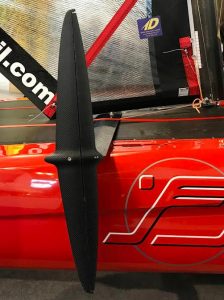
early take off in lightest breeze
F oiling maneuvers are heavily supported, superior flight attitude through active foil control, dynamic control of f light high , pitch and role, non-linear control and feedback control system for best flight stability, even in waves, the foils do not need to be manually manipulated, optimized performance: advanced sailors can adjust rake and gearing, more about flysafe®>>>, active flight assistance, the foil can be trimmed actively while sailing, the key to maximum performance , mdt for performance-orientated pro sailor, mdt extends the flysafe® foil control, to sail large xxl rigs, more about main foil differential ->>>, performance downwind: staying on the foils, full foiling, in 5-6kts tws, reaching max. boat speeds of up to 2.5*tws, performance upwind: full foiling from 8kts. tws, taking off from 7kts tws, video youtube channel, ifly15 foiling catamaran.

The most innovative development in foiling technology
About ifly15, stable flight is key for both: first for highest performance and foiling in a wide wind range, including rough and wavy conditions, but also easy access into foiling…...
iFLY stands for uniqueness in design and function. Its superior Flysafe ® active foil control system autonomously supports the stable horizontal flight position in the longitudinal and lateral direction. The 4 T-Foils do not have to be operated by the sailor during sailing.
Average skilled dinghy or catamaran sailors with some trapeze experience can safely foil with the iFLY15 after only a few hours. Quick access – the immediate sensation of success – steep learning curve. In the hand of an experienced sailor, iFLY15 offers a whole new sailing experience with previously not experienced speeds and agile maneuverability.
The flight control system, combined with numerous fine-tuned innovations , ensures safe foiling even in strong winds and rough seas.. Stable flight attitude allows pushing hard, so in good conditions, iFLY reaches high boat speed beyond 30 knots in a controllable way.
IFLY15 offers freedom to fly alone or in pairs. Due to the exclusive use of high-tech materials , iFLY15 is extremely rigid and weighs less than 90 kilos ready to sail. With its low weight and its state-of-the-art hydrofoils, it is airborne in winds as low as 2Bft. / 6 Knots.
iFLY15 has a length of only 15 feet, is easy to transport, quick to get ready to sail, and can be easily slipped from the beach using a conventional beach trolley.
Its sophisticated design reflects the highest demands on quality and function.
iFLY15 – customer reviews
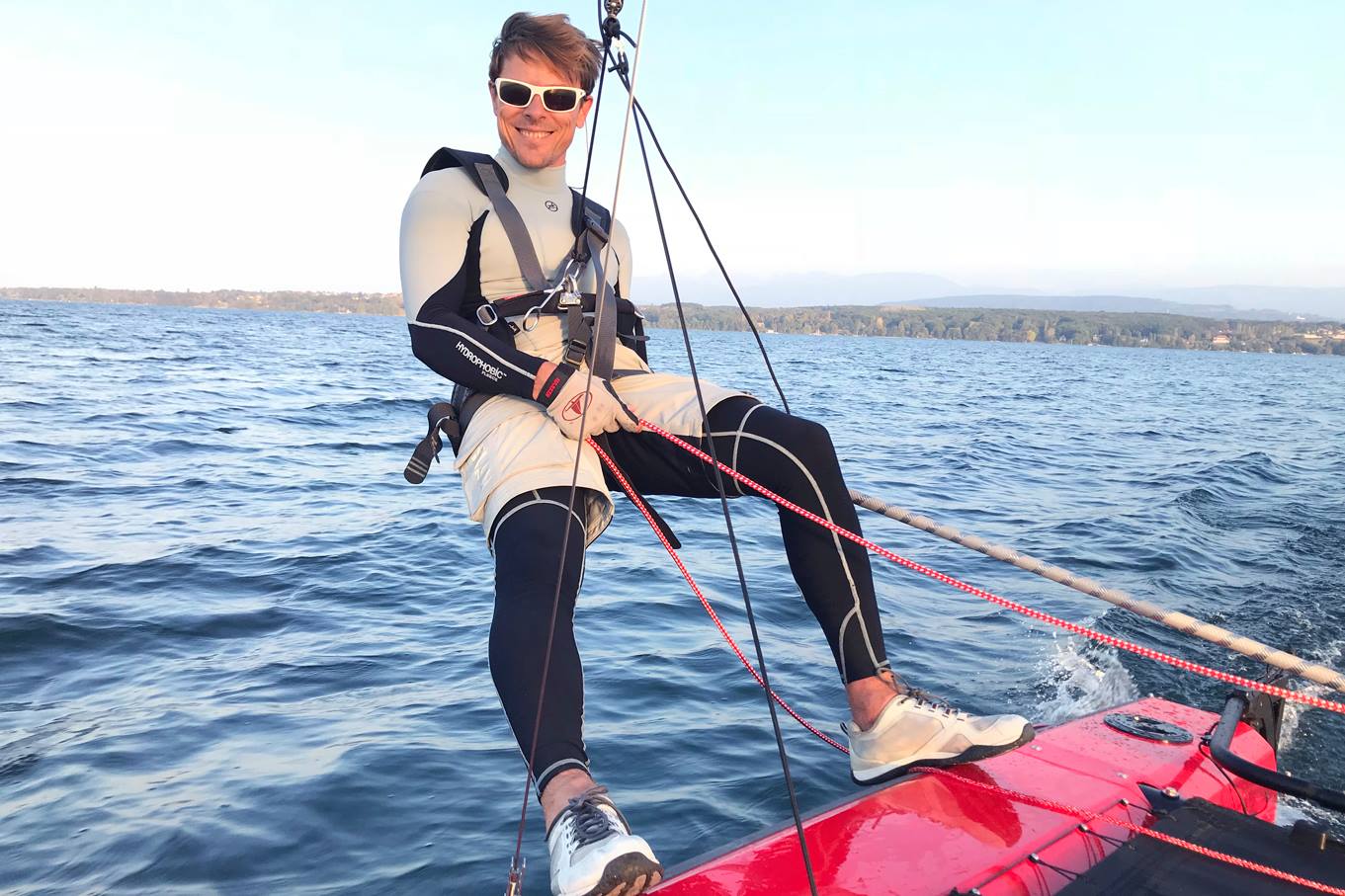
« LESS CRASHING IS MORE FUN »
MARCUS LYNCH, PROFESSIONAL SAILOR AND OLYMPIC COACH, GC32 OMAN, NACRA17
« I WAS INITIALLY AMAZED AT HOW EASY TO HANDLE THE IFLY IS AND AT HOW IDLE THE BOAT IS EVEN IN STRONG WINDS. »
ANTOINE, IFLY OWNER FROM GENEVA
VERY STABLE, EXTRAORDINARY STABLE. IT IS EXTREMELY INTERESTING, BECAUSE YOU IMMEDIATELY SEE THE ACCESSIBILITY OF THE BOAT.
FRANÇOIS GABART
« GREAT BOAT, LIKE A MOTH ON STEROIDS ! »
VICTOR DIAZ DE LEON, MIAMI, PROFESSIONAL SAILOR. US TEAM SAILGP, INTERNATIONAL MOTH, MATCHRACING MELGES 32, J70
WHAT A GREAT BOAT THIS IS, AND I ABSOLUTELY LOVE IT”
PHILIP WALKER
« THE DYNAMIC FLIGHT CONTROL SYSTEM ALLOWS LONG AND STABLE FLIGHTS »
GERHARD FLORIN, IFLY OWNER FROM GENEVA, SWITZERLAND
TO FELLOW SAILORS WHO LOVE THE THRILL OF SAILING WITH SPEED WHILE MAINTAINING CONTROL”
ROY BALLENTINE
« WELL BALANCED AND RAKE DIFFERENTIAL ALLOWING FOR GREAT PERFORMANCE UPWIND! »
CARLOS ROBLES,PROFESSIONAL SAILOR 49ER, PALMA DE MALLORCA
« A SENSATIONAL FOILING EXPERIENCE. THE SPEED IS IMPRESSIVE »
INGMAR WARNICKE: COMMODORE OF YCSO, YACHT CLUB SCHARBEUTZ, BALTIC SEA
⭐ ⭐ ⭐ ⭐ ⭐

IFLY RAZZOR PRO – THE NEW IFLY FOR EXPERIENCED SAILORS
THE SINCE 7 YEARS PROVEN IFLY15 WITH FLYSAFE® DYNMAMIC FOIL CONTROL has now a pur Racing fellow: THE iFLY RAZZOR Pro. THE iFLY racing VERSION ENABLES EVEN HIGHER PERFORMANCE, to sail in extremely tough conditions and allows sailing with XXL rigs. THE MAIN DIFFERENCE BETWEEN THE IFLY15 ONE DESIGN AND THE IFLY RAZZOR PRO IS A BIGGER RACING RIG, SPECIAL FOILS AND THE MAIN FOIL DIFFERENTIAL (MDT), WHICH IS MANUALLY TRIMMED BY THE SAILOR. THE MDT IS WORKING HAND IN HAND WITH THE FLYSAFE® DYNAMIC FOIL CONTROL SYSTEM.
flying – sailing – Blog
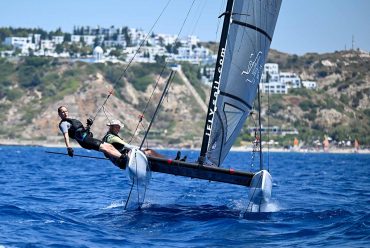
“We’re taking off! Foiling is THE Watersports Trend! – „Boot International 2024“ in Düsseldorf / Germany once again showcases: Foiling is THE trend in watersports.
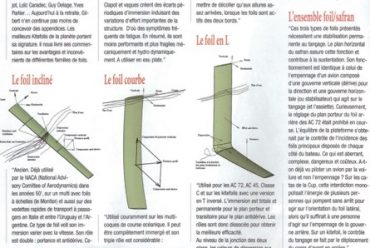
Performance Sailing – Sail GP News: Racing on the Edge – T-Foil proves to be the winning design

Regatta and foiling News: Long distance Race – Duc d’Albe 2023 – Club Multicoques Hyères – sailing Race @iFLY Razzor Pro
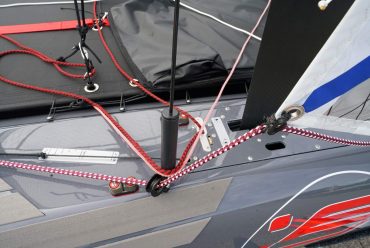
iFLY Main Foil Differential Technology – MDT Foil Control – high Performance sailing
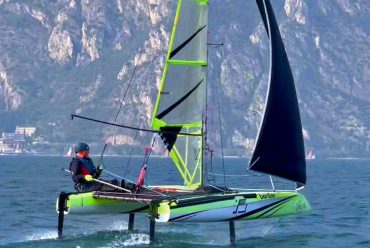
IFLY FOILING Adventure
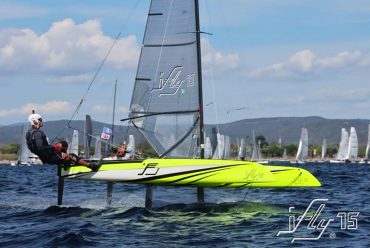
FOILING – REGATTA – EVENTS
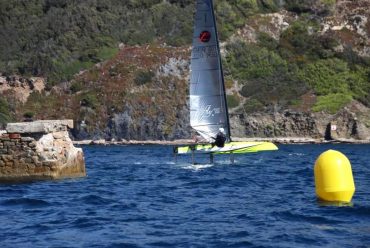
Long distance Race – Duc d’Albe 2021 – Club Multicoques Hyères – sailing Race @iFLY Razzor Pro
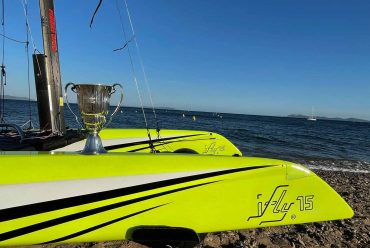
INTERNATIONAL IFLY foiling FLEET RACE 2021

iFLY15 successfully crossing the English channel / world record Attempt Cowes to Dinard / Saint Malo
Catamaran europe central, the iflysail team, is looking forward to your message.

Association Française des Catamarans de Classe A
Bienvenue sur le site de l’association française des catamarans de classe a .
Le Classe A regroupe maintenant deux pratiques distinctes qui s’inscrivent toujours dans un esprit d’évolution, mais avec des restrictions différentes:
Le Classe A open, autorisant le vol, est le précurseur de la voile actuelle, en utilisant les libertés de la jauge afin d’atteindre des vitesses encore plus grandes en étant libéré de la résistance de l’eau.
Le classe A classic s’inscrit dans la prépondérance du jeu stratégique de la régate avec des restrictions supplémentaires, notamment pour les dérives et safrans.

Stage Hyères
Début le
6 mars 2017

Coupe de Printemps
11 mars 2017

Championnat de Bretagne
18 mars 2017

Décès de Matthias Dietz
30 avr. 2024
MAINTENANCE SERVICES WEB
30 janv. 2024
CLOTURE DU RETOUR DES FEUILLES DE VOTE AG-2023 AU 15 JANVIER 2024
7 janv. 2024

Réaliser des pad-eyes légers
22 mars 2021

Réaliser des inserts de footstraps sur un bateau construit en sandwich nid d'abeille
7 déc. 2020

Retirer le pad de son classe A
15 nov. 2020


IMAGES
VIDEO
COMMENTS
Unique design enables top performances. The F1x A-class foiling catamaran is the ultimate reflection of our current design language. The aerodynamic design accentuates the performance qualities of this super fast foiling racing boat. The sophisticated deck plan provides clear control and minimal air resistance. The rudders and daggerboard foils ...
The A-Class Catamaran, often abbreviated to A-Cat, is a development class sailing catamaran for singlehanded racing. Background. The class was founded during the late 1950s and was part of the 4-tier IYRU (now World Sailing) approach to divide up the sports catamaran sailing scene into 4 separate groups. ... 2022 Foil Bruce Mahoney ...
A-Class: Learning to Foil the Exploder (Part III) Unusual cold rainy winter this year, so not much sailing. The F18s have been racing and training for the Worlds past months, but the 'Panzer tanks' can sail in almost any condition, with the F18 you can go out and charge +25knots and hard chop/waves. With the A for me the plan is always to ...
eXploder AD3 is A-Class sailing catamaran - one of the fastest singlehanded sailing boats on the water. The eXploder A-Class cats have been in production since 2013 and in that time won a staggering 6 World Championship titles and 15 Continental titles ... All the foil trimming systems are clean and easy to operate on any course, allowing on ...
Forward foil has higher heave stiffness than aft foil. Fully submerged aft foil (T rudders) Stern-first takeoff. This talk only concerns heave stability of boards. A-Class Design Requirements. Vertical lift = 160 kg. 75 kg boat. 85 kg crew. Righting moment (about centerline) = 180 kg m.
Other types of foiling catamarans include the Nacra 17, the A-Class, and the Formula 18. The Nacra 17 is a two-person performance catamaran, while the A-Class and Formula 18 are both one-person boats. All three of these catamarans use hydrofoils to lift the hull out of the water, and are popular in competitive sailing.
Hydrofoil catamarans work by using foil-shaped wings that protrude from the bottom of the boat, below the water line. The foils are designed to lift the vessel out of the water, reducing the surface area touching the water, and therefore reducing drag. As the boat moves forward, the airflow on the foils generate lift, causing the boat to rise ...
Technical Section. In this section, you will find explanations, setup advice and some videos about various technical aspects of the 'A' Class Catamaran, all provided by expert sailors and designers to help you to get the best from your boat. It covers both Classic and Foiling designs.
The Foil Cat holds 400 gallons of fuel and with twin Mercury 400 Verado engines, has a 600-700-mile range, cruising at an easy 32 mph. That horsepower and speed provides an economical 2 mpg burn. The amidship location of the 28" foils come into play as the boat planes, balancing the amount of boat in the water, both foils and propulsion units ...
A quick explanation of the basic steps and technique needed to initiate the foil downwind on a foiling A Class Catamaran.
Performance. Handling. Manoeuvre. Class Association. A great number of innovations all over the catamaran and the perfect match of all components allow controlled high-speed foiling experience. iFLY15 is full of innovations, e.g. in hull design, hydrofoils, rudders, automatic flight control system, two-layer wing trampoline, high performance ...
Tutorial of DNA Performance sailing for the F1 A-class foiling catamaran on how to set the forestay. Check out this video and learn all about connecting the ...
Hydrofoil sailboats have wing-like foils mounted under the hull. As the hull speed increases due to the pressure on the sails (in some cases with just 10 knots of true wind), the hull lifts out of the water, reducing the wetted surface and decreasing drag. ... The DNA F1 A-class catamaran is designed for single-handed foiling. The carbon pre ...
His latest project is a 29' (8.8m) foil-assisted planing cruising power catamaran designed for twin outboards from 60 hp to 90 hp. Last fall, construction was far advanced as Brandt prepped for finishing, outfitting, and getting the boat ready for sea trials off St. Augustine, ... The centerpiece of the foil project is a 20 ...
Hydrofoiling wingsail catamaran 17. A sailing hydrofoil, hydrofoil sailboat, or hydrosail is a sailboat with wing-like foils mounted under the hull.As the craft increases its speed the hydrofoils lift the hull up and out of the water, greatly reducing wetted area, resulting in decreased drag and increased speed. A sailing hydrofoil can achieve speeds exceeding double and in some cases triple ...
Wing and jib. Mast length. 18 m (59 ft) - 24 m (79 ft) Class is a member of World Sailing. ← AC50. [ edit on Wikidata] The F50 is a one-design foiling catamaran used in the SailGP race series. The name is an abbreviation of " F oiling" and "a hull length of 50 feet". [1] The F50s are adapted from the AC50s used in the America's Cup, with ...
Hydrofoil catamarans can reach speeds of up to 40 knots (46 mph) or more, depending on the design and conditions. The foils on a hydrofoil catamaran can lift the hulls out of the water, reducing drag and allowing for a smoother and faster ride. Hydrofoil catamarans are used for various purposes, including racing, recreational sailing, and even ...
The Eagle Class 53 is a wingmasted cruising catamaran designed to fly on T-foils. ... The proposed T-foil daggerboards will be angled out which makes the overall platform slightly wider, which in ...
The official site for the British 'A' Class Catamaran Association. Designed to inform new and existing 'A' Cat sailors about UK 'A' Class trends. Official Partner _MG_8601. 185A7873. Mich Davidson _MG_8601. 1/30. ... (or foiling version) fitted with J and Z shaped boards, together with T or L rudders allow skilled sailors to foil the boats ...
A Class Catamaran (International) Site: Download Boat Record: Notes. The A CLASS CATAMARAN has undergone a steady evolution since the rule was first established in 1962. Dimensions listed are class limits, and beyond these few restrictions, the class is fairly open. Sailboat Forum. View All Topics: ...
The S9 foiling catamaran use a different systems foil from other flying catamarans (such as A Class and C Class): S9 is the first foiling catamaran that uses 4 point constantly at work in the water, more easy , more stable ! WIth the "T" foil s9 there is an automatic adjusting trim tabs called "Wand". This system is used only in the ...
The flight control system, combined with numerous fine-tuned innovations, ensures safe foiling even in strong winds and rough seas.. Stable flight attitude allows pushing hard, so in good conditions, iFLY reaches high boat speed beyond 30 knots in a controllable way. IFLY15 offers freedom to fly alone or in pairs.
Bienvenue sur le site de l'Association Française des Catamarans de. Classe A ! Le Classe A regroupe maintenant deux pratiques distinctes qui s'inscrivent toujours dans un esprit d'évolution, mais avec des restrictions différentes: Le Classe A open, autorisant le vol, est le précurseur de la voile actuelle, en utilisant les libertés ...